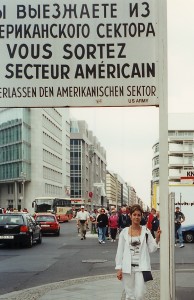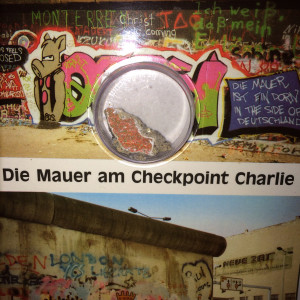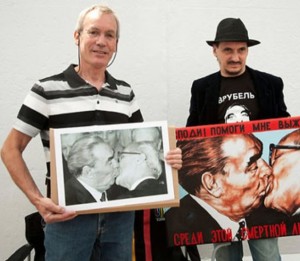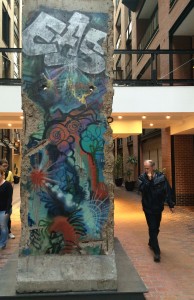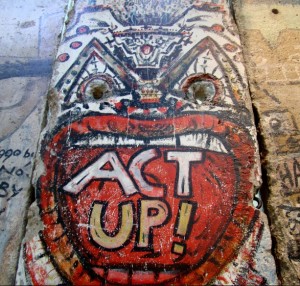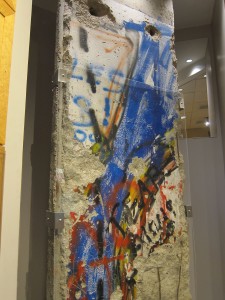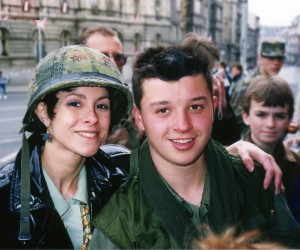 On May 4, 1991, the people of Plzen, Czechoslovakia, were celebrating “American Day” to mark the 46th anniversary of their city’s liberation from the Nazis by General George S. Patton’s U.S. Army at the end of World War II. It was a major event, and I was lucky to be there to take part in it.
On May 4, 1991, the people of Plzen, Czechoslovakia, were celebrating “American Day” to mark the 46th anniversary of their city’s liberation from the Nazis by General George S. Patton’s U.S. Army at the end of World War II. It was a major event, and I was lucky to be there to take part in it.
I had arrived in Czechoslovakia on April 25 to begin a public relations campaign on behalf of Westinghouse Electric Corporation. At that time, my company was hoping to form a joint venture with a Plzen firm – Skoda – for the purpose of producing power generation equipment. When I heard about the American Day celebration scheduled to take place on May 4, I saw a PR opportunity I couldn’t pass up.
 With the help of a Czech businessman I chanced to meet in Prague, I began working with Plzen city officials to secure two exhibit booths to serve as Westinghouse hospitality areas during the two-day event. Knowing I’d need plenty of assistants, I visited the American Hospitality Center in Prague and hired four young Czech students to run errands and act as interpreters. Now, what’s an exhibit booth without trinkets and other giveaways? I phoned headquarters back in Pittsburgh (no easy task, given the horrible telephone connections) and asked my colleagues to FedEx a box of Westinghouse logo-embossed items, such as frisbees, cups, hats, buttons, and tote bags, as well as large company banners to display in the booths.
With the help of a Czech businessman I chanced to meet in Prague, I began working with Plzen city officials to secure two exhibit booths to serve as Westinghouse hospitality areas during the two-day event. Knowing I’d need plenty of assistants, I visited the American Hospitality Center in Prague and hired four young Czech students to run errands and act as interpreters. Now, what’s an exhibit booth without trinkets and other giveaways? I phoned headquarters back in Pittsburgh (no easy task, given the horrible telephone connections) and asked my colleagues to FedEx a box of Westinghouse logo-embossed items, such as frisbees, cups, hats, buttons, and tote bags, as well as large company banners to display in the booths.
 Oh, and we needed music – preferably American music. I had seen a Dixieland Band comprised of Czech musicians busking on the Charles Bridge in Prague, and hired them to provide entertainment near our booths. And no exhibit area is complete without booze. So, I sent the Czech students on numerous trips to the huge local brewery to bring back cases of beer. And not just any beer, mind you. This was Plzen, where brewers began making the world-famous Pilsner Urquell beer in 1892.
Oh, and we needed music – preferably American music. I had seen a Dixieland Band comprised of Czech musicians busking on the Charles Bridge in Prague, and hired them to provide entertainment near our booths. And no exhibit area is complete without booze. So, I sent the Czech students on numerous trips to the huge local brewery to bring back cases of beer. And not just any beer, mind you. This was Plzen, where brewers began making the world-famous Pilsner Urquell beer in 1892.
The sound of New Orleans jazz filled the air as I distributed the various goodies to the revelers, who proudly wore the original uniforms their liberators had left behind in 1945. Like all citizens of Soviet Bloc countries, the Czechs had been cut off from American culture for 50 years, and watching them celebrate the USA in this manner was a moving experience.
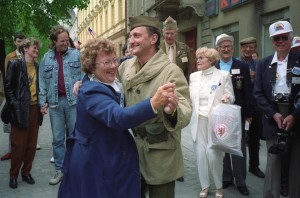 At one point during a ceremony, an official led the people of Plzen in a prayer of gratitude. In the background, I could see the old stone buildings still scarred with bullet holes from WWII battles. I was experiencing history in a way I’d never imagined.
At one point during a ceremony, an official led the people of Plzen in a prayer of gratitude. In the background, I could see the old stone buildings still scarred with bullet holes from WWII battles. I was experiencing history in a way I’d never imagined.
My first attempt to organize an event in a newly-democratic country proved quite challenging, given the short deadline, poor telecommunication systems, and my inexperience in the world of international public relations. And even though the joint venture with Skoda never materialized, Czechs had their first exposure to the Westinghouse name, and their first taste of American-style promotion.
© Dana Spiardi, May 6, 2015
]]>
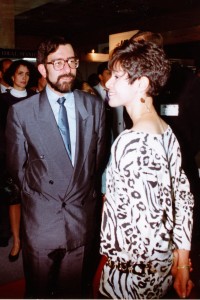 Westinghouse’s high-profile nuclear plant upgrade project in Bulgaria generated a lot of media attention and I was often thrust into the spotlight. My interviews and photos appeared in a dozen Bulgarian newspapers through the years. I even appeared on Bulgarian television nightly news! (See clip below.)
Westinghouse’s high-profile nuclear plant upgrade project in Bulgaria generated a lot of media attention and I was often thrust into the spotlight. My interviews and photos appeared in a dozen Bulgarian newspapers through the years. I even appeared on Bulgarian television nightly news! (See clip below.)
One of my tasks involved organizing the company’s participation in Bulgaria’s International Plovdiv Fair from 1991 through 1995. Our large exhibit space gave us a venue for meeting with customers, media and government officials. At left I’m talking to former Prime Minister Filip Dimitrov at the fair in 1992.
During that same year I visited the Soviet-designed Kozloduy nuclear plant. A May 1992 issue of Time magazine featured a cover story on the facility, titled “Europe’s Nuclear Nightmare.” The feature began with a series of quotes from a disgruntled nuclear plant worker who said the plant “could blow up at any minute.” Because Westinghouse was contracted by the Bulgarian utility company to upgrade the plant’s safety systems, Kozloduy management asked me to prepare a policies and procedures document that would help the utility improve its public information programs and prevent leaks to the press.
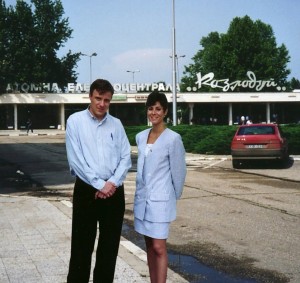 So, what does one wear when visiting a nuclear nightmare? How about a pin-striped, seer-sucker suit and four-inch heels. As usual, I was inappropriately dressed for walking through an industrial area. Later, I cracked open my forehead as I was getting in the car to leave the facility. This nuclear accident caused quite a stir, as plant workers poured out of the building to help me. Oh well, at least I can say my hot, home-style lunch in the plant cafeteria was the best meal I’ve ever eaten at a nuclear facility. Pictured in the photo with me is my friend Boyan Setchensky, the brilliant engineer from our office in Sofia, Bulgaria.
So, what does one wear when visiting a nuclear nightmare? How about a pin-striped, seer-sucker suit and four-inch heels. As usual, I was inappropriately dressed for walking through an industrial area. Later, I cracked open my forehead as I was getting in the car to leave the facility. This nuclear accident caused quite a stir, as plant workers poured out of the building to help me. Oh well, at least I can say my hot, home-style lunch in the plant cafeteria was the best meal I’ve ever eaten at a nuclear facility. Pictured in the photo with me is my friend Boyan Setchensky, the brilliant engineer from our office in Sofia, Bulgaria.
© Dana Spiardi
]]>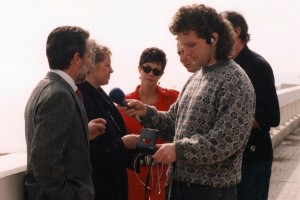 In the early 1990s ,the Czech government sought international nuclear suppliers to help complete a partially-built Soviet-designed nuclear plant called Temelin. Westinghouse, the sole American bidder for this half-billion dollar contract, had been virtually unknown in the Soviet Union during the Cold War years. I was charged with launching a major public relations program to inform the public of the company’s capabilities.
In the early 1990s ,the Czech government sought international nuclear suppliers to help complete a partially-built Soviet-designed nuclear plant called Temelin. Westinghouse, the sole American bidder for this half-billion dollar contract, had been virtually unknown in the Soviet Union during the Cold War years. I was charged with launching a major public relations program to inform the public of the company’s capabilities.
But where to begin? Public relations wasn’t exactly a social science in the Soviet Bloc. I sought out local experts to help me understand the Czech culture and mentality. I wanted to deliver messages that mattered, in a manner that wouldn’t offend the media or the company’s potential Czech customers and partners. I must have interviewed a dozen people as possible consultants, until I finally found a man who truly had his finger on the pulse of Czech society: Michal Donath, a virtual one-man-show in the Prague branch of the global Burson Marsteller PR firm. His contributions were invaluable.We conducted numerous one-on-one interviews with many journalists and – in the days leading up to the award of the contract – organized a large press conference to answer journalists’ questions en masse. Nearly 100 reporters were able to get answers directly from the head of our nuclear energy division, Nat Woodson.
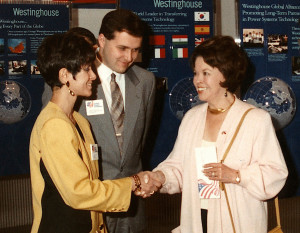 We also arranged a media tour for fifteen Czech journalists in early 1993. Within a 7-day period I took the group – which included a TV crew – to England, Belgium, Switzerland, and Spain to visit nuclear plants designed by Westinghouse. This gave them a chance to witness the technology first-hand and speak directly with our utility customers. A number of the reporters were anti-nuclear, so this PR program proved to be quite a challenge. But the resulting press coverage was generally good and provided the Czech public with an in-depth look at our capabilities as the world’s leading nuclear supplier.
We also arranged a media tour for fifteen Czech journalists in early 1993. Within a 7-day period I took the group – which included a TV crew – to England, Belgium, Switzerland, and Spain to visit nuclear plants designed by Westinghouse. This gave them a chance to witness the technology first-hand and speak directly with our utility customers. A number of the reporters were anti-nuclear, so this PR program proved to be quite a challenge. But the resulting press coverage was generally good and provided the Czech public with an in-depth look at our capabilities as the world’s leading nuclear supplier.
It also helps if you have a good Ambassador, and we had one in the form of Shirley Temple Black, the former child star turned diplomat (photo at left). She served the U.S. in Czechoslovakia from 1989 through 1992. Ambassador Black was an energetic public servant and worked hard to help Westinghouse in its efforts to win the contract. I was thrilled to have the chance to chat with her on numerous occasions.
Throughout this 5-year PR campaign I also had the wonderful opportunity to meet with former Czech President Alexander Dubcek (photo at right, below), who attempted to reform the Communist Party in Czechoslovakia in the late 1960s. The Soviets quashed his popular movement by rolling their tanks into Prague’s Wenceslas Square in the summer of 1968, effectively ending the short-lived Prague Spring.
 While we were slowly winning over the Czech public, bordering countries such as Austria had their own concerns about the necessity and safety of the Temelin reactor. They targeted Westinghouse with endless letters, all of which arrived in my office. Even Greenpeace knew my name. They once greeted me with anti-nuclear banners as I exited the customs area at the Zurich airport! Pretty scary stuff.
While we were slowly winning over the Czech public, bordering countries such as Austria had their own concerns about the necessity and safety of the Temelin reactor. They targeted Westinghouse with endless letters, all of which arrived in my office. Even Greenpeace knew my name. They once greeted me with anti-nuclear banners as I exited the customs area at the Zurich airport! Pretty scary stuff.
But In the end, our efforts paid off. Westinghouse won the contract and continues to have a presence in the country. I ended up making 10 trips to the Czech Republic in five years. The work was exciting and exhausting, fascinating and frustrating. And I wouldn’t trade one minute of those experiences – good or bad – for anything. Those years truly were my personal Prague Spring.
© Dana Spiardi
]]>